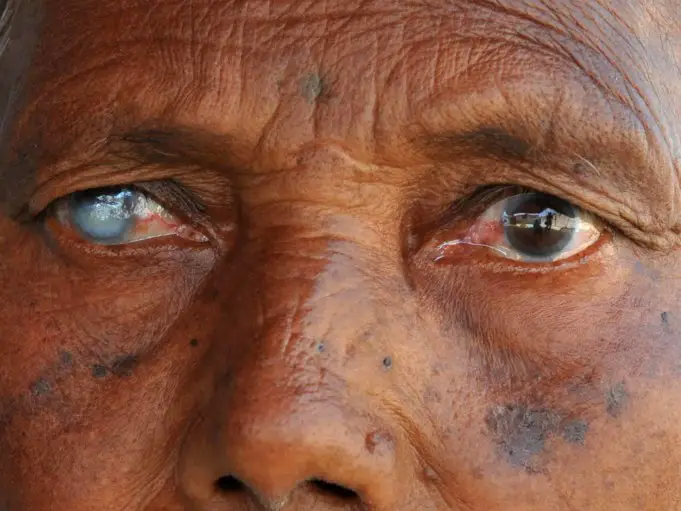Blindness is defined as the inability to see anything. It is a state of being sightless. A person may be partially blind, which means they have limited vision.
For instance, vision may be blurry, and it may be difficult to distinguish between the shapes of objects. Complete blindness, however, is the inability to tell the difference between darkness from bright light in both eyes.
Legal blindness is a condition where vision is highly compromised. What a person with normal vision can see from 200 feet away, a legally blind person can see only from 20 feet away.
Low vision means that despite contact lenses, eyeglasses, medicine, or surgery, a person cannot see well. According to the World Health Organization, about 1 billion people have a vision impairment.
About 50 million people in this demographic are completely blind. The risk of blindness increases with age; approximately 80% of blindness occurs in people aged 50 and above.
It is essential to seek medical attention immediately if you suddenly lose the ability to see. This may increase your chances of restoring vision, depending on the cause of blindness.
Types of Blindness
- Night blindness is the inability to see in decreased lighting conditions. This condition may be genetic or acquired. People who have night blindness typically function well under normal lighting conditions.
- Color blindness is the difficulty in perceiving the difference between various shades of colors, especially green and red, that others can distinguish. Color blindness is often genetic and affects males more than females. People with color blindness usually have normal vision and can function normally.
- Snow blindness is the loss of vision due to exposure to high amounts of UV light. This condition occurs as a result of swelling of the cells of the corneal surface, and is usually temporary. The affected individual can still perceive shapes and movement even in severe cases of the condition.
Causes and Risk Factors for Blindness
Eye diseases and conditions that can cause blindness include:
- Cataracts cause cloudy vision and are common in older people.
- Glaucoma, a group of eye conditions that can damage the optic nerve responsible for carrying visual information from the eyes to the brain.
- Macular degeneration is a common eye condition in older adults that destroys the eye that sees fine details.
- Tumors that affect the optic nerve or retina can result in blindness.
- A lazy eye may lead to vision loss. It can make it difficult to see details.
- Retinitis pigmentosa, which refers to damage of the retina, may lead to blindness in rare cases.
- Birth defects
- Complications from eye surgery
- Eye injuries
Socio-economic factors also play a role in the development of blindness. In developed nations, the leading cause of blindness include:
- Macular degeneration
- Ocular complications due to diabetes
- Traumatic injuries
- Glaucoma
In developing nations, vision impairment occurs as a result of cataracts, infections, injuries, glaucoma, and lack of access to medicated glasses. Infectious diseases that can cause blindness include
- River blindness
- Trachoma
- Leprosy
- Herpes simplex
Other causes of blindness include
- Vitamin A deficiency
- Retinopathy of prematurity
- Blood vessel diseases involving the retina or optic nerve include stroke, ocular inflammatory disease, and chemical poisoning from toxic agents such as methanol.
Risk factors for blindness include:
- Poor nutrition
- People with eye diseases, such as macular degeneration and glaucoma
- Failing to wear safety glasses when indicated
- People with diabetes
- People who smoke
- People who have a stroke
- People with a family history of blindness
- People undergoing eye surgery
- Advancing age
- People who work with or near sharp objects or toxic chemicals
- Premature babies
- Poor prenatal care
Signs and Symptoms of Blindness

Complete blindness means the inability to see anything. People who are partially blind may experience the following symptoms.
- Poor night vision
- Inability to see shapes
- Cloudy vision
- Seeing only shadows
- Tunnel vision
Signs of vision impairment in children include:
The symptoms of visual impairment in young children can include:
- Extreme sensitivity to light
- Chronic eye redness
- A white instead of black pupil
- Chronic tearing from the eyes
- Constant eye rubbing
- Poor focusing
- Unusual eye alignment or movement after six months of age
- Trouble following an object with their eyes
Diagnosis
An optometrist would examine the eyes to help determine the cause of blindness or partial loss of vision. The tests involved would measure:
- The clarity of vision
- The function of eye muscles
- Pupils’ react to light
Treatment
One or more of the following treatment options may help restore vision in cases of vision impairment:
- Eyeglasses
- Contact lenses
- Surgery
- Medication
In cases where partial blindness cannot be corrected, the doctor will provide guidance on how to function with limited vision. For instance, the use of magnifying glass to read and increasing text size on computers and mobile devices.
Complete blindness requires that the person learns new skills to cope with the condition. This includes
- Learning how to read Braille
- Using a guide dog
- Organizing your home so you can easily find things and stay safe.
You can also consider getting some adaptive products, like a specialized smartphone, color identifier, and accessible cookware.
Prevention
It is essential to get regular eye exams to detect eye diseases and help avoid vision loss.
Sources
- What You Need To Know About Blindness – Healthline
- Blindness and Vision Impairment – WHO
- Blindness; Causes, Types, and Treatment – MedicalNewsToday












